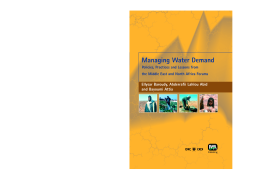
Additional Information
Book Details
Abstract
The vast arid and semi-arid regions of the Middle East and North Africa region (MENA) constitute 85% of the region's land area and are home to approximately 60% of the region's population. Limited water resources pose severe constraints on people's economic and social progress, testing their resilience and threatening their livelihoods. Rainfall is not only scarce and unpredictable, but the region is also subject to frequent and severe droughts. Available surface water is declining and the over-pumping of groundwater beyond natural recharge rates is occurring, lowering the water table and causing an increase in groundwater salinity and ecological degradation. Water Demand Management (WDM) is about governance and tools that motivate people and their activities to regulate the amount and manner in which they access, use and dispose of water to alleviate pressure on freshwater supplies. It is also about protecting water quality. The development and promotion of such WDM practices, primarily for governments in the Middle East and North Africa (MENA) region, have constituted the core objectives supported by Canada?s International Development Research Centre (IDRC) and its partners through the Water Demand Management Forums. Managing Water Demand provides a comprehensive account of the tools used to manage water demand in the MENA region. A critical review is presented of the efficacy of WDM techniques in the areas of wastewater reuse, water valuation, public-private partnerships and decentralization, and participatory irrigation management. This book will provide some of the necessary knowledge required to further promote WDM in the MENA region, while providing insight into the work required for much needed change to improve water governance.
